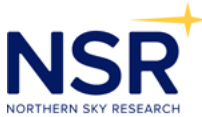
NSR’s Satellite Constellations: A Critical Analysis report, just released, forecasts a mixed outcome for large HTS constellations.
NSR predicts two, out of the five Non-GEO HTS constellations analyzed, do not have a viable business case and will not be sustainable, if launched. The remaining three will generate 12 percent of overall SATCOM market revenues over the next decade. Costly systems and replenishment cycles, matched against funding challenges, demand questions, and extraordinary technical and regulatory complexity, will separate contenders from pretenders in the high stakes constellations market.
Vertical integration trends — such as in-house manufacturing and, in the case of SpaceX, incorporating that with its own launch services — aimed at lowering costs further actually add another layer of complexity that is greatly underestimated. Supply chain management is a momentous challenge, even for industries that are conceived on a mass production model with years of experience, such as the automotive industry. Various other production and assembly processes need to be redesigned, and testing and safety standards need to be re-evaluated for the specific cases of mass producing satellites.

There is a compelling level of optimism toward Non-GEO constellations, as evidenced by the huge amount of funding being poured into them. The availability of low latency Internet service across the globe offers tremendous socio-economic benefits. However, financial success for LEO constellations depends on their ability to bring pricing down to a level competitive with terrestrial networks and make the services affordable to target markets. With advancement in Technology Readiness Levels (TRL) of Flat Panel Antennas, Inter Satellite Link (ISL) technology and manufacturing trends such as 3D printing, the overall CAPEX for LEO constellations is expected to be reduced in the coming years, which will aid in the realization of their envisioned business models.
NSR’s Satellite Constellations: A Critical Analysis report provides a competitive assessment of satellite constellations within three markets: Communication HTS, IoT and EO. The report analyses various aspect of the business case including launcher strategy, ground infrastructure costs, manufacturing and replenishment plan as well as financing status for each constellation to assess their viability. The financial ‘bottom line’ for each is scrutinized and compared against a qualitative assessment to evaluate the future of these constellations. NSR further evaluates the growth trends of NGEO constellations within each market under study over a 10-year period.
Shagun Sachdeva, NSR Analyst and the report 's author, notes that constellations are not a new concept and, historically, they have not been an entirely successful venture. The associated CAPEX, including replenishment costs, is one the biggest hurdles to HTS, EO, and IoT constellation business plans. The reduced launch and manufacturing costs are indeed enabling trends; however, there are still many challenges, like those associated with ground infrastructure costs and acquisition of landing rights, that must be overcome to build a feasible business model. The benefits from economies of scale, which mega-constellations rely upon, are generally not enough to counter these other challenges.
For additional information on this report, including a full table of contents, list of exhibits and executive summary, please visit this direct link...

